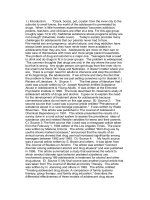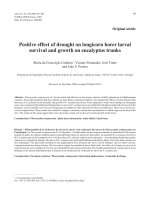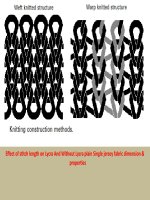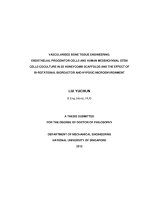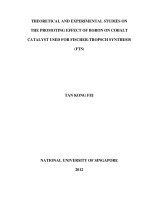Effect of atmospheric temperature, relative humidity and rainfall on disease development of Alternaria alternata causing alternaria leaf spot and fruit rot of chilli under natural
Bạn đang xem bản rút gọn của tài liệu. Xem và tải ngay bản đầy đủ của tài liệu tại đây (268.4 KB, 5 trang )
Int.J.Curr.Microbiol.App.Sci (2019) 8(1): 2860-2864
International Journal of Current Microbiology and Applied Sciences
ISSN: 2319-7706 Volume 8 Number 01 (2019)
Journal homepage:
Original Research Article
/>
Effect of Atmospheric Temperature, Relative Humidity and Rainfall on
Disease Development of Alternaria alternata Causing Alternaria Leaf Spot
and Fruit Rot of Chilli under Natural Conditions
Manjul Pandey1*, P.K. Dwivedi2, R.P. Mishra3 and Mukesh Srivastava3
1
Krishi Vigyan Kendra, Banda, Banda University of Agriculture and Technology,
Banda-210001(UP), India
2
Krishi Vigyan Kendra, Raisen (MP), India
3
Department of Plant Pathology, C. S. Azad University of Agriculture & Technology,
Kanpur-208002, India
*Corresponding author
ABSTRACT
Keywords
Chilli (Capsicum
annuum),
Epidemiology,
Alternaria
alternata, Leaf spot,
fruit rot
Article Info
Accepted:
17 December 2018
Available Online:
10 January 2019
The data correlated regarding the effect of atmospheric temperature, relative
humidity and rainfall on disease development during 2002-03 and 2003-04
revealed that, moderate relative humidity accompanied by nearly moderate
temperature favoured disease development in both the years. The maximum
disease development was recorded in the second fortnight of November during
both the years. The average maximum and minimum temperatures and relative
humidities were 29.7ºC, 13.6ºC and 87.5, 39.2 per cent, respectively during 200203, whereas during 2003-04 average maximum and minimum temperature were
34.0ºC and 15.4 ºC, respectively with average maximum and minimum relative
humidities of 73.3 and 45.2 per cent, which led to maximum disease development.
The rainfall in January led to rise in relative humidity and fall in atmospheric
temperature hampered the disease development.
Introduction
Chilli (Capsicum annuum L.) is used as
condiment as well as vegetable in every
household of India. It has an important role in
our daily diet. The fruits of chillies are used to
increases the palatability and taste of cooked
food and vegetable chilli is used to flavour
soups, stews and sauces. The pickle of chillies
is preferred by the masses. It is used in every
vegetarian as well as non-vegetarian diet of
the world. India is the major producer and
exporter of chillies and their products to
various countries including Abudhabi,
Australia, Canada, Japan, U.S.A. and U.K.
(Anonymous, 1992). According to Peter et al.,
(2004), in India, chillies are grown or
cultivated in an area of 9.65 lakh ha with the
2860
Int.J.Curr.Microbiol.App.Sci (2019) 8(1): 2860-2864
production of 10.75 lakh tonnes. This
contributes 35.5 per cent and 31.6 per cent,
respectively, to the total area and production
from all spices. In India, almost all the states
cultivate chillies. However, Uttar Pradesh,
Madhya Pradesh, Tamil Nadu, Andhra
Pradesh,
Karnataka,
Punjab,
Bihar,
Maharashtra, Gujarat are the major chilli
producers. In Uttar Pradesh, chillies are grown
in 20,900 hectares with a total annual
production of 16,400 tonnes. Chillies are the
best and the cheapest source of vitamin C and
A. The green chillies also contain rutin
(C27H30O16), which has specific medicinal
value (Purseglove, 1977). The pungency of
chilli is due to an alkaloid, “Capsaicin (C
18H27NO3).” The red colour in fruit at the
ripening stage is due to the pigment
Capsanthin (Nath, 1969). Chilli is valued
throughout the world for pungency. The
pungent principle of red pepper consists of a
mixture of seven closely related allyl
vanillyamides named Capsaicinoides, which
are separated by solvent extraction of the dried
fruits and the subsequent removal of the
solvent (Tiwari, 1990; Govindrajan, 1985;
Maya, 1975).
Materials and Methods
To find out the effects of atmospheric
temperature, relative humidity and rainfall on
disease development, a highly susceptible
chilli variety „Chaman‟ was sown in the field.
Recommended doses of fertilizers and cultural
practices were used and irrigation were
applied whenever necessary. The data on
disease development were recorded every 15
days of interval during 2002-2003 and 20032004. The weather data also recorded during
the crop period and correlated with the disease
development.
Results and Discussion
Atmospheric temperature, relative humidity
and rainfall play a very important role in
disease development. Therefore, it was felt
desirable to study the role of these factors in
the epidemiology of Alternaria leaf spot and
fruit rot of chilli by the technique described in
"Material and Methods'. The disease intensity
under natural conditions was recorded at
fortnightly intervals on the crop grown at
vegetable Research Farm, Kalyanpur Kanpur.
The prevailing atmospheric temperature,
relative humidity and rainfall were noted from
the observatory installed in the vicinity and
correlated with disease development and
necessary observations were taken (Table 1,
Fig. 1). The results summarized in Table 1
reveal that environmental factors, viz.,
atmospheric temperature, relative humidity
and rainfall play significant role in disease
intensity.
There is fairly good correlation between
atmospheric temperature, relative humidity
and rainfall and disease intensity. The disease
appeared in the first fortnight of July which
gradually increased upto first fortnight
November and thereafter, there was a decline
in disease intensity with lowering down of
temperature and relative humidity upto the
month of January.
Maximum disease intensity (36.9%) during
year 2002-03 and (36.5%) during 2003-04, in
first fortnight of November, when the
maximum
and
minimum
atmospheric
temperature varied between 29.7-13.6ºC in the
year 2002-03 and 24.0-15.4ºC during year
2003-04, respectively and relative humidity
varied upto 87.5–39.2 per cent (2002-03) a nd
73.3- 45.2 per cent (2003-04). However, there
was no effect of rainfall on the disease
development, as there was no rain during the
said period. The minimum intensity (10.3 and
10.9 per cent) was observed in August when
both the atmospheric temperature and the
relative humidity were high, while in the
month of January the disease intensity was
observed low (29.3 and 28.1 per cent).
2861
Int.J.Curr.Microbiol.App.Sci (2019) 8(1): 2860-2864
Table.1 Effect of atmospheric temperature, relative humidity and rainfall on disease
development under natural conditions
Period
Average temperature (ºC)
2002-03
Average relative humidity (%)
2003-04
2002-03
2003-04
Average
rainfall (mm)
2002-
Disease intensity
(%)
200304
2002-03
2003-04
03
Max.
Min.
Max.
Min. Max.
Min.
First fortnight of July
39.6
30.8
31.4
21.6
60.6
39.5
83.3
57.3
0.0
15.6
10.3
10.9
Second fortnight of
July
40.4
30.4
31.8
20.8
70.8
55.1
91.2
64.8
1.7
8.5
11.8
12.4
First fortnight of
August
33.1
26.9
31.2
19.9
87.4
71.8
91.7
65.0
13.3
5.2
15.1
15.0
Second fortnight of
August
34.4
27.5
34.0
24.1
99.2
78.8
92.1
73.8
4.6
2.4
19.2
18.9
First fortnight of
September
30.3
24.4
32.0
21.5
90.3
79.6
93.3
88.1
26.0
30.3
21.9
24.7
Second fortnight of
September
32.3
23.1
31.7
24.3
86.1
62.6
91.0
83.4
0.0
5.6
25.3
26.6
First fortnight of
October
33.3
21.8
33.5
20.8
78.9
48.4
82.8
60.7
0.1
0.0
28.7
30.3
Second fortnight of
October
33.9
20.1
34.5
20.3
88.6
44.2
89.6
55.3
0.1
0.0
31.2
34.0
First fortnight of
November
29.7
13.6
34.0
15.4
87.5
39.2
73.3
45.2
0.0
0.0
36.9
36.5
Second fortnight of
November
27.9
15.1
27.1
18.0
84.5
36.0
79.1
47.6
0.0
0.0
35.1
36.0
First fortnight of
December
23.3
16.2
26.7
11.1
85.0
32.6
83.8
57.4
0.0
0.0
33.5
32.8
Second fortnight of
December
25.1
7.9
20.4
9.0
95.3
50.3
86.6
50.6
0.0
1.8
30.2
28.5
First fortnight of
January
13.4
3.0
16.6
6.2
95.6
77.9
85.0
79.2
0.8
0.0
29.3
28.1
2862
Max.
Min.
Int.J.Curr.Microbiol.App.Sci (2019) 8(1): 2860-2864
Fig.1 Effect of environmental factors on disease development
The reason being instead of increase in
relative humidity, the lowering down of
atmospheric temperature continues to lower
down disease intensity and the rainfall does
not show significant any effect on it. Thus, it
may be concluded that in general the
maximum and minimum temperature and
relative humidity have an impact on disease
development, where the high temperature
together with high humidity keeps the disease
2863
Int.J.Curr.Microbiol.App.Sci (2019) 8(1): 2860-2864
intensity low, whereas low temperature
together with comparatively low humidity
favour high disease development. The
maximum disease development was recorded
in the first fortnight of November during
2002-03 and 2003-04. The average maximum
and minimum temperatures and average
maximum and minimum relative humidities
were 29.7ºC and 13.6ºC and 87.5 per cent and
39.2 per cent, respectively during 2002-03,
whereas during 2003-04 average maximum
and minimum temperatures were 34.0ºC and
15.4ºC, respectively with average maximum
and minimum relative humidities of 73.3 and
45.2 per cent led to maximum disease
development. The rainfall in January led to
rise in relative humidity and fall in
atmospheric temperature hampered disease
development. No work on the epidemiology
of this disease has been done before.
However, Ghewande (1986) found that
temperature between 25ºC to 29ºC and
relative humidity of 87 per cent were more
favouable for the development of Alternaria
leaf spot of ground nut incited by Alternaria
alternata. Patel and Patel (1991) reported that
temperature range of 25-40ºC and high
relative humidity favoured the development
of tomato rots in open market caused by
Alternaria alternata. Singh and Majumdar
(2000) observed that Alternaria alternata
caused major rot disease in pomegrante. The
rotting was maximum at 25ºC temperature
and 90 per cent relative humidity.
References
Anonymous (1992). Estimated export of chilli
from India during 1991. Spice India, 5(1):
20.
Ghewande, M.P. (1986). Epidemiology of foliar
diseases: Annual Report National Research
Center for Groundnut, Junagarh, p. 30-31.
Govindrajan, V.S. (1985). Capsicum production
technology, chemistry and quality. Part II.
Processed products standards, world
production and trade. C.R.C. Critical
Review in Nut. 23(3): 207-288.
Maya, J.A. (1975). Capsicum. C.R.C. Critical
Review in Food, Sci., Nut., 6(2) : 177-193.
Nath, P. (1969). Vegetables for the Tropical
Region. Indian Council of Agricultural
Research, New Delhi, Book Series No. 2.
Patel, R.B. and Patel, G.S. (1991). Post harvest
diseases of tomato and their control.
Indian. J. Agric. Res., 25: 173-176.
Peter, K.V; Nybe, E.V. and Thanuja, T.V. (2004).
Future prospects. Survey of Indian
Agriculture. The Hindu. 56-59 pp.
Purseglove, J.W. (1977). Tropical Crops.
Dicotyledons I & II. Longman, London,
U.K.135-136 pp.
Singh, Jitendra and Majumdar, V.L. (2000).
Epidemiology and management of post
harvest disease of Pomegranate caused by
Alternaria alternata. Indian J. Mycol. Pl.
Tiwari, V.P. (1990). Development of high
capsaicin chillies (Capsicum annuum L.)
and their implications for the manufacture
of export products. J. Plant Crops. 18 (1):
1-13.
How to cite this article:
Manjul Pandey, P.K. Dwivedi, R.P. Mishra and Mukesh Srivastava. 2019. Effect of
Atmospheric Temperature, Relative Humidity and Rainfall on Disease Development of
Alternaria alternata Causing Alternaria Leaf Spot and Fruit Rot of Chilli under Natural
Conditions. Int.J.Curr.Microbiol.App.Sci. 8(01): 2860-2864.
doi: />
2864

